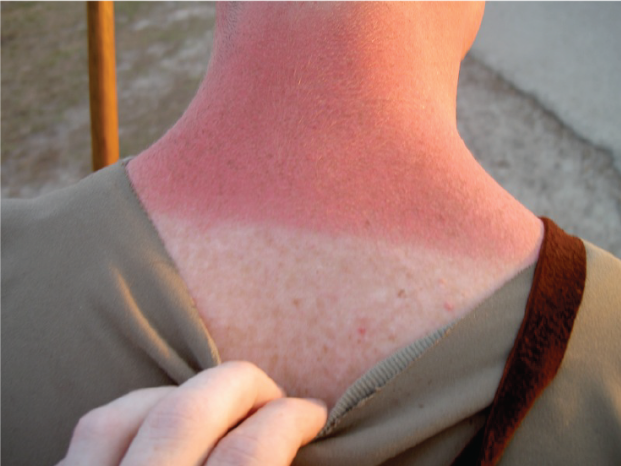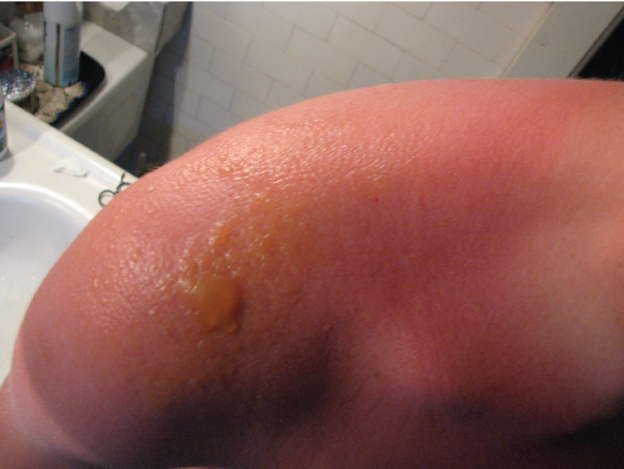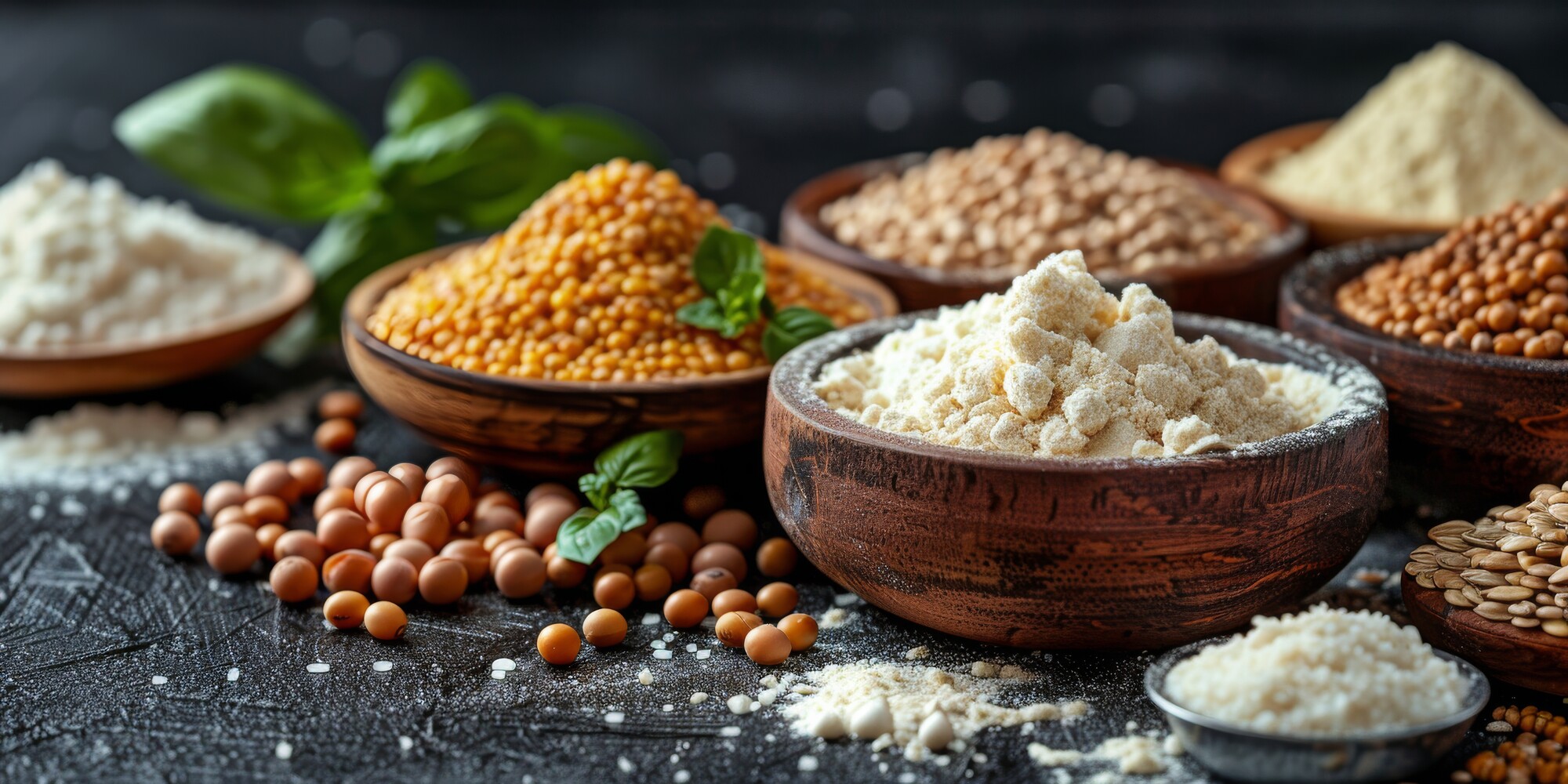1. The symptoms of sunburn
1. 1 Sunburn as a 1st and 2nd degree burn
In medicine, sunburn is also referred to as "dermatitis solaris". This means something like "sun-induced skin inflammation". However, the colloquially more common name "sunburn" is also justified [1].
After all, it is (as "burn" already suggests) actually a burn of the skin - more precisely, a 1st to 2nd degree burn. This means [1, 2]:
- 1st degree burn
- The symptoms include pain, redness and swelling.
- Only the top layer of skin ("epidermis") is affected.
- Complete healing is to be expected.
- 2nd degree burn
- Complaints include pain, redness and blisters.
- The uppermost and parts of the middle layer of skin ("dermis") are affected.
- Glands and other skin appendages remain intact.
- There are no scars. However, there may be permanent differences in pigment or texture.
- 2nd degree burn (2b)
- The symptoms include redness and blisters.
- Pain is less common here.
- Deep layers of skin are also affected.
- Healing is accompanied by scarring.
These stages already show the variation in the extent of sunburns. However, even more severe burns (grade 3 and 4) are not to be expected from UV rays [2].
1.2 Duration
The duration of sunburn depends heavily on the extent of the burn. It typically begins 3 to 8 hours after UV exposure. The sunburn then reaches its maximum after around 12 to 24 hours [1, 3].
1.3 Itching, pain, redness and swelling
The symptoms of sunburn usually start with itching and pain. Redness limited to the UV-exposed skin area then follows slightly later. Slight swelling due to inflammation is also possible [1, 3].
In addition, blistering is possible with severe burns [1, 3]:

1.4 Blisters
If the sunburn is severe, blisters and vesicles may develop. This then corresponds to a 2nd degree burn [1, 3].
The background to this is that in these cases parts of the middle layer of the skin ("dermis", grade 2a) or even deeper layers of the skin (grade 2b) are also affected [1, 3].
The blisters usually heal within 7 to 10 days. Scarring is rare but possible. There may also be permanent differences in pigmentation or texture of the skin [1, 3].

1.5 Special localizations
In principle, sunburn can affect any area of skin. However, areas that are rarely covered by clothing and that "face the sun" are particularly frequently affected [1, 3].
These include in particular the hairless scalp, the forehead, the auricles, the lower lip, the forearms, the backs of the hands and the fingers [1, 4].
1.5.1 Sunburn on the face and head
As the face is rarely covered by clothing, it is one of the most common locations for sunburn. The same applies to the scalp - especially if there is no or sparse hair [1, 3].
1.5.2 Lips
The lips are also susceptible to sunburn. In addition to the symptoms mentioned above, a typical symptom here can also be increased dryness or brittleness [1, 3].
1.5.3 Eyes
The eyelids are also among the "sun terraces" of the body that are particularly exposed to UV radiation. Increased susceptibility is also due to the fact that many people - understandably - do not want to get sun cream in their eyes and therefore avoid the eye area when applying sun cream [1, 3].
2. Sunburn on babies and children
Babies and children are exposed to a particularly high risk from UV radiation. On the one hand, this is due to the fact that they spend more time outdoors and, on the other hand, they are not yet able to assess the health risk themselves [7].
According to studies, however, there is another aggravating factor [7]:
Excessive sun exposure at a young age, for example, is associated with a particularly high risk of developing skin cancer later in life. This is because the skin of babies and children is even thinner and their cells are often still immature - which makes them particularly susceptible [7].
To prevent immediate and later damage to health, it is therefore essential to protect all minors from excessive UV exposure. This also helps them to develop skin protection as a long-term habit [7].
3. What to do in case of sunburn
3.1. Behavior in case of sunburn
As there is no specific treatment for sunburn that could reverse the skin damage, avoiding further sun exposure is by far the most important measure [1, 8].
If further sun exposure cannot be avoided, it is all the more important to apply plenty of sun cream with an appropriately high sun protection factor and to wear long clothing, headgear and sunglasses [9].
However, there is a whole range of treatment options that can at least alleviate the symptoms caused by sunburn [1, 8].
4. Treatment of sunburn
4.1. Pain relief
In general, moist compresses can provide effective relief. However, if the pain is more severe, painkillers such as ibuprofen or diclofenac can be used [1, 8].
However, the dosage should always be based on the information in the package leaflet or on the recommendations of a doctor or pharmacist. Treatment can be initiated as soon as the first symptoms appear [1, 8].
After 24 to 48 hours, the pain usually subsides on its own so that the medication can then be discontinued [1, 8].
4.2.Treatment for redness and itching
Symptoms such as redness and itching are also due to the UV-induced inflammatory reaction. Since medications such as ibuprofen and diclofenac have an anti-inflammatory component, the question arises as to whether they - in addition to pain relief - also have an effect on other inflammatory symptoms of sunburn [8]. There are currently no high-quality studies on this.
However, smaller, experimental studies suggest that the pain medications mentioned above may reduce UV-related redness. This was successful if the medication was administered before or immediately after radiation [8]. However, this would have no effect on possible UV-related consequential damage such as skin cancer, which is why - in contrast to the use of sunscreen - it is not recommended [8].
4.3. Medicated creams
Medicated creams with a cooling effect and skin preparations containing Bepanthen can also provide relief after sunburn. However, these products cannot reverse the skin damage either. In addition, tolerability varies from person to person [1, 8, 10].
However, if you have severe sunburns, you should see a doctor immediately. In the case of ruptured blisters, it is advisable to carry out careful cleaning and cover the open skin areas with moist bandages [8]. In the course of this, a decision can then be made about an appropriate medical cream [8].
4.4. Home remedies for sunburn
4.4.1. Aloe vera, Aftersun and Co.
Over-the-counter aloe vera or so-called aftersun products are generally harmless and can be used to relieve symptoms after (mild) sunburn [8].
However, these lotions are also unable to reverse the skin damage. Routine use is therefore strongly discouraged [8].
5. Consequences of sunburn
5.1. Pigmentation disorder and scarring
While mild sunburns (first degree burns) are usually accompanied by complete healing, more severe burns can be associated with permanent skin changes [1, 2].
In sunburns that correspond to grade 2a (see above), parts of the middle layer of skin (“dermis”) are affected in addition to the top layer. In these cases there are no scars. However, permanent differences in pigmentation or texture of the skin can occur [1, 2].
In the case of very severe sunburns (grade 2b), deeper layers of the skin can also be affected. In this case, healing can be accompanied by permanent scarring [1, 2]. Scars can also occur if sunburned skin is scratched excessively.
5.2. Circulatory shock
A severe sunburn (second degree burn) can lead to what is known as circulatory shock. This is possible if the sunburn affects over 10% of the body surface and is accompanied by blistering [1].
In this way, the smallest blood vessels – the so-called “capillaries” – can be damaged. If this is the case, fluid moves from the bloodstream into the tissue. This makes it more difficult for the rest of the body to receive sufficient oxygen [1]. In children, this can happen with as little as 5% of the body surface area burned. Severe sunburns should therefore always be seen by a doctor and treated if necessary [1].
5.3.
Skin cancer
Increased UV exposure is one of the most important risk factors for skin cancer. This is particularly true if the exposure is frequent and severe - i.e. with subsequent sunburn. Light skin types are most at risk [11].
Depending on the cell type affected, various forms of cancer are possible as a result. The most common include so-called malignant melanoma and squamous cell carcinoma of the skin [11, 12].
The contents of this article reflect the current scientific status at the time of publication and were written to the best of our knowledge and belief. However, the article cannot replace medical advice and diagnosis. If you have any questions, contact your general practitioner.
The contents of this article reflect the current scientific status at the time of publication and were written to the best of our knowledge. Nevertheless, the article does not replace medical advice and diagnosis. If you have any questions, consult your general practitioner.
Originally published on







